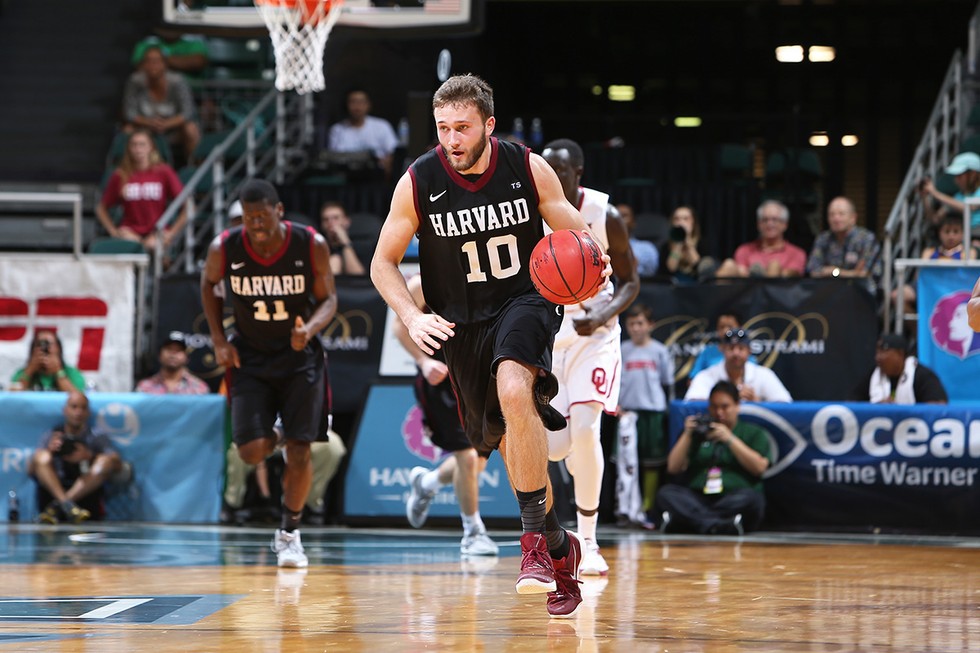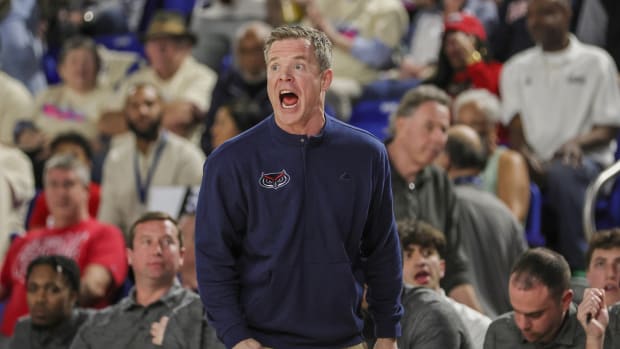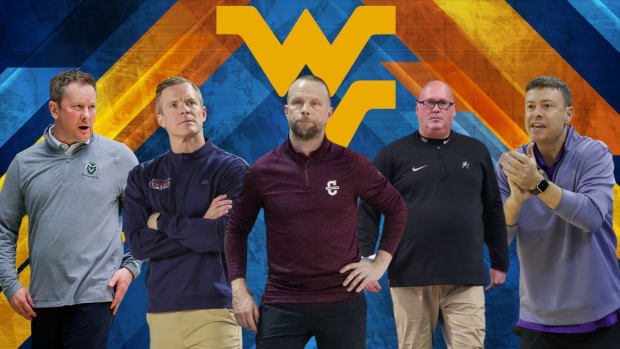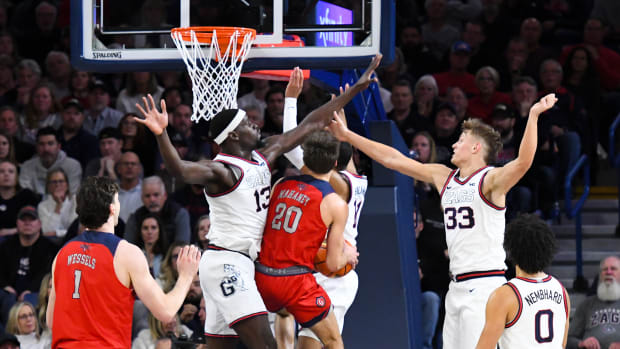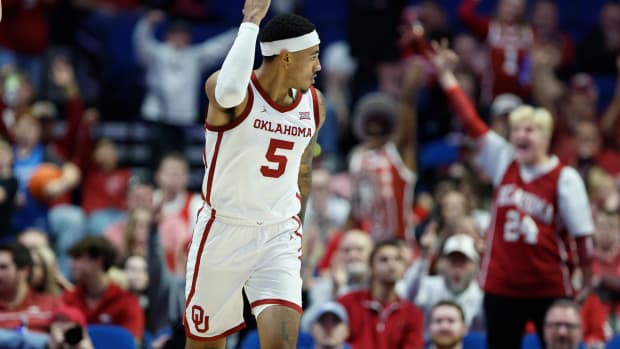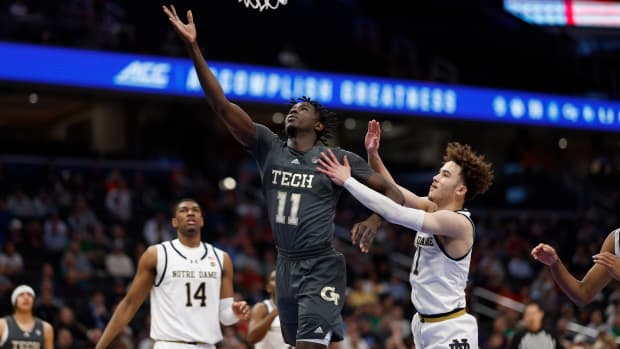After three injury-plagued seasons on the sidelines, Patrick Steeves emerges as sixth man for Harvard
Patrick Steeves knows what it's like to be stuck on the bench. The sixth man for Harvard understands the ache of not playing, and the questions that come with it: What am I even doing here? Is this worth it? Am I not supposed to be a college basketball player?
For Steeves, there was always one other question: Am I ever going to get healthy?
The answer to that wound up being yes. But not before missing three full seasons due to injury.
Now a 21-year-old senior, Steeves comes off the bench to score 8.4 points, grab 4.2 rebounds and hand out 2.4 assists per game for the 10–14 Crimson. If he thinks about the promise he had coming into Harvard, he's disappointed. But if he thinks about the journey to get back on the floor, he's elated. "For me, there's joy anytime I step on the floor," he says. "Before this season, I hadn't played in a real game since the summer before my freshman year—there was a part of me that didn't really remember what playing the game even felt like."
Steeves, a Montreal native, graduated one year early, in 2012, from the Hotchkiss School in Lakeville, Conn., because he felt bored and unchallenged academically. Initially, the 6'7" forward planned to spend summer 2012 on the AAU circuit, improving his game and attracting college coaches' attention. (He says that before graduating early, Penn State had shown some interest.) But he grew restless in the classroom, and that winter opted instead to reclassify to the 2012 recruiting class. He enrolled at Harvard—he's an applied mathematics major—that fall and scored 14 points in 20 minutes in the Crimson's preseason scrimmage in late October. That production off the bench assured him that, even though he had hit fast-forward, he could play Division I basketball.
Two weeks later, doctors discovered a stress fracture in the fifth metatarsal of his left foot. The long bone that connects with the pinky toe tends to heal slowly because of bad blood supply, and by the time Steeves was healthy in late February, there were no minutes for an inexperienced rookie. So Steeves camped out on the bench as Harvard rolled to a 20–10 season and won an NCAA tournament game against New Mexico before falling to Arizona in the Round of 32
Redshirts are not available in the Ivy League, so Steeves couldn't get the season back. Ivy League athletes are allowed to play only the first eight semesters they're in school, so the only way to regain a season would have been to drop out of school for a year and then re-enroll. (Student-athletes in the Ivys can apply for a fifth year of eligibility specifically for academic purposes, but must be able to demonstrate they're not under pressure from coaches to do so.) That wasn't an option. Steeves went home to Montreal to train for the summer, telling himself three years was plenty of time to make an impression.
Back on campus the following fall with his foot fully healed, Steeves heard the dreaded "POP!" in his right knee during an intrasquad scrimmage one week before the Crimson's first game. Harvard trainers did a quick on-site test and confirmed the worst: He'd torn his ACL, and there was no shot at playing in 2013–14.
"The ACL was the worst in terms of pain, and even mentally, having to get the surgery, the length of rehab, all of it," Steeves says now. "When you're out of surgery you feel like a baby. You can barely walk, and it feels like you're so far away from playing basketball again."
Steeves spent the season rehabbing, watching away games on the Ivy League Digital Network alone in his dorm room, and sitting on the bench at home. He traveled to the NCAA tournament in Spokane, celebrating in the stands and later the locker room, when 12th-seeded Harvard knocked off No. 5 seed Cincinnati, 61–57, in the East Region. (The Crimson lost in the Round of 32 to Michigan State). That summer he interned at a Cambridge startup and returned to Harvard happy, healthy and anxious to play. Then, in a pick-up game on campus in late summer, he fell awkwardly again on his right knee.
"It felt like something was off, but it never occurred to me that I would miss the whole season because of it," Steeves says. "But pretty soon it was the same story over and over: 'Let's set a comeback date for three weeks from now ..." but I could never string together more than one or two practices in a row. I'd practice, and then not be able to walk down stairs the next day. It was a roller coaster."
When multiple image testing wasn't conclusive, doctors opted for a second ACL surgery, figuring they might need to clean out debris or scar tissue. They found Steeves's ACL still strong and intact, but discovered that during the initial tear, a small piece of his tibial plateau bone had broken off. Instead of trying to fix or reattach it, doctors chiseled it down, prescribed more rehab and sent him home.
"At this point, I've rehabbed more than I've played," Steeves says.
"When he was going into his third surgery, I felt for him," says Evan Cummins, a senior forward for the Crimson. "If it was me, I'd be completely devastated. But as he was going into his third surgery [to fix the bone] he says to me, 'Hey, third time's supposed to be a charm, right?' That positivity was just unfathomable to me."
Courtesy Harvard Athletics
Staying involved with the team—and still feeling like a valuable member—wasn't as tricky as some might assume, Steeves says. Fluent in French (his mother works as a journalist for a French-speaking TV station in Canada) and a math and economics junkie, he's a popular team tutor. He lived with fellow Canadian Agunwa Okolie, a senior swingman from Ontario, and showed up to every practice and every film session, encouraging teammates and giving them, says coach Tommy Amaker, a daily dose of inspiration. Amaker plans to use Steeves story of resiliency for seasons to come.
"Anytime we'd feel bad for ourselves, we'd look at Pat and it's like, he's been battling for three years," Cummins says. "He's dying just to practice. His experience might not show up in number of games played, but when he speaks, he's a voice people respect."
Finally, after an agonizing three years, Steeves played in his first college basketball game on Nov. 7, 2015, in an exhibition against McGill. He scored the first point of his college career six days later when Harvard opened the regular season with a 59–39 win over MIT. When he connected on that free throw with 1:02 left in the game—he went 1-for-2 at the line and grabbed one rebound in two minutes of play—his teammates gave him a standing ovation. "Seeing everybody on the bench going nuts," he says, "that was incredibly meaningful to me."
Cummins understands the joy and relief Steeves felt that night again MIT, but says Steeves's most meaningful minutes came on Dec. 31, in a 77–57 win over Wofford. In the first half, Steeves was out on the wing denying a pass. When his man cut to get open, Steeves shadowed him, eventually stepping in front of him and cutting off a path to the basket while contesting a shot. "I go to position myself for a rebound, and all the sudden, he's blocked this guy right out of bounds over the bench," Cummins says. "I think for our team, that was his arrival as a consistent contributor."
Steeves swears that at no point did he seriously consider quitting, though moments of doubt crept in, especially during long rehab sessions. He describes himself as "demoralized, but not depressed," during those moments, but leaned on his teammates, who reassured him that they wanted him back. Mostly, he felt the need to prove—especially to himself—that he could play college basketball. "Knowing I had that fourth year, I wouldn't have been able to live with the doubts or regrets of 'what could have been' if I didn't try to come back," Steeves says.
Though he's close to graduation and has a job offer at a consulting firm in Boston, Steeves isn't sure he's ready to give up hoops just yet. And he might not have to: He is a candidate to become an NCAA graduate transfer, and could play the 2016–17 season elsewhere.
"I'm certainly not ruling it out," Steeves says. "There's an argument to be made that I've got to make up for some lost time."
